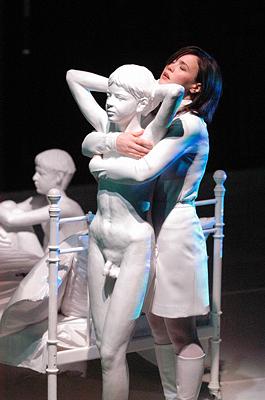|
<< -- 3 -- David Wilkins THE THINNEST TIGHTROPE

Problems begin with the opening scene of the Governess' arrival at Bly -- not so much with the realisation that all the characters are going to be dressed in white (a deft contradiction of expectations as well as locating the story in a more dreamlike, psychologically suspect realm). Not so much, either, with the realisation that the entire action takes place in a shallow pool of splashing water (it is, paradoxically, both a medium of innocence and the location of its drowning). Not even, really, with the naked statues of the children or the stagehands dressed as white-robed-and-hatted cardinals who shift bits and pieces with long hooks. The difficulty is with allowing the audience to find a point of focus. Large sail-like sheets are used for video projections at either side of the action and, because of the audience's close proximity, it's impossible to take in the full stage picture. It feels too alienating too early in the story to be forced into Wimbledon-spectator head movements. As if in anticipation of the provocative scenes to come, you can be forgiven for saying, 'I didn't know where to look!'

The Governess (Eszter Wierdl) in the Hungarian première production of Britten's 'The Turn of the Screw'. Photo © Béla Mezey
|
The Governess is good, though. Wierdl Eszter hardly looks even the twenty-year-old of James' tale and, like almost the entire cast, has a voice in full sympathy with Britten's idiom. Strange how many times during the evening -- because of the venue and the Hungarian language -- Bartók springs to mind: Bluebeard's Castle is never far away and nor are those insect-ridden 'nightmusic' sounds so prevalent in Bartók.
Continue >>
Copyright © 29 February 2004
David Wilkins, Eastbourne UK

|

